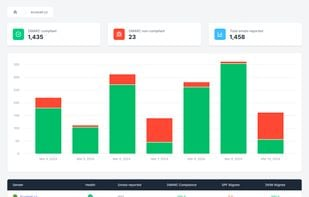Feature set
DMARCEye offers a comprehensive suite of DMARC reporting and monitoring features, prioritizing ease of use with its AI-powered analysis. It effectively processes aggregate DMARC reports, making it simple to identify and categorize email sending sources, detect potential forwarding loops, and pinpoint spoofing attempts.
Beyond core DMARC report visualization, DMARCEye provides smart alerts, email notifications, and integrations with collaboration tools like Slack and Microsoft Teams. For larger organizations, the enterprise tier includes API access, allowing for custom integrations into existing security or operations platforms.
DMARC-SRG, an open-source PHP script, focuses on the fundamental task of parsing DMARC aggregate reports and generating summary reports. Its feature set is much more focused, providing the raw data and basic visualizations needed to understand DMARC compliance and identify sending sources.
As a self-hosted tool, DMARC-SRG's capabilities are limited to what the script provides, without advanced features like real-time alerts, multi-user management, or integrations. It requires users to manage their own hosting environment and cron jobs for report processing, putting the onus of operations entirely on the user.
































 4.5 / 5(1)
4.5 / 5(1) 0 / 5(0)
0 / 5(0)

